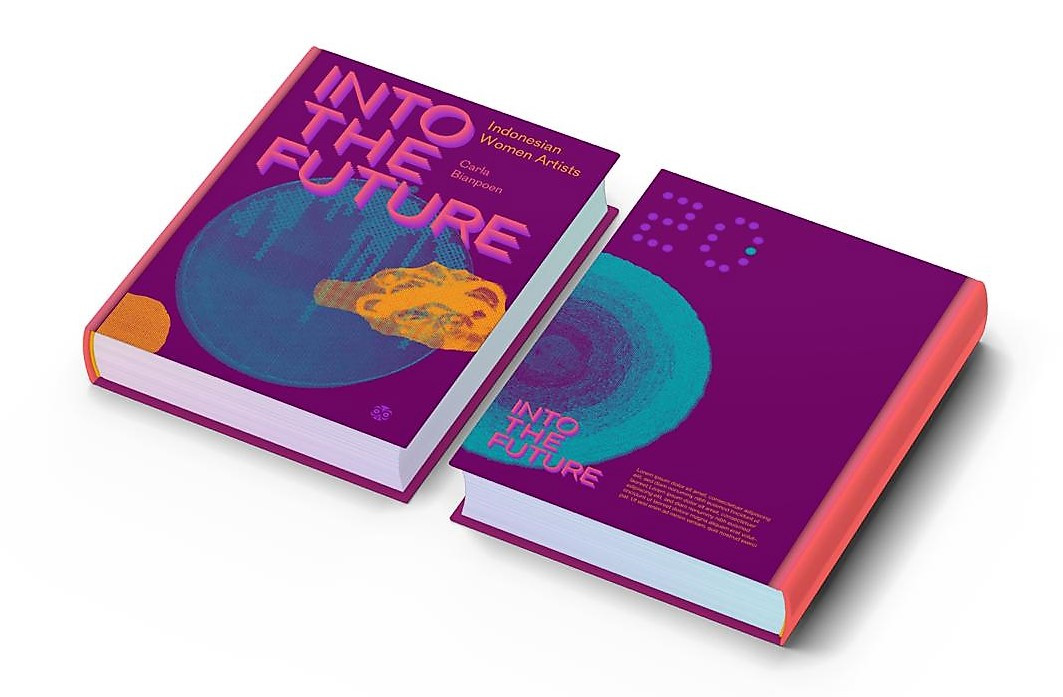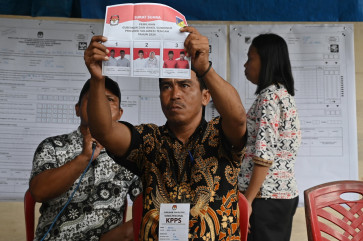Popular Reads
Top Results
Can't find what you're looking for?
View all search resultsPopular Reads
Top Results
Can't find what you're looking for?
View all search resultsSpellbound by ‘Into the Future: Indonesian Women Artists’
One of the most notable things about the book Into the Future: Indonesian Women Artists written by veteran art critics and curator Carla Bianpoen is its sheer presence.
Change text size
Gift Premium Articles
to Anyone
O
ne of the most notable things about the book Into the Future: Indonesian Women Artists by veteran art critic and curator Carla Bianpoen is its sheer presence.
The cover uses bold futuristic graphics – in vibrant colors with strong debossed typography and the effect is confident: it is unavoidable and in your face. Yet this large scale, heavy, hardback book pulses with energy both literally and figuratively.
The nearly fluorescent pink-tipped page-ends emit a glow that captivates even before opening the 311-page book, published by Cemara Enam Foundation.
It is fitting that the book projects this vitality because once one starts to browse through the works of 21 female artists featured inside, one senses the sheer physicality of the work and the women. It is an amazing achievement.
For anyone who braved the journey to the National Gallery of Indonesia in Jakarta for the exhibition, which took the same title as the book, this book will be instantly recognizable as a companion piece to the exhibition.
The book has the same innovation and carried the same humanity. However, unlike the exhibition that was free for all, this book costs a whopping Rp 2 million (US$146.64). So, is it worth it?
The book starts with erudite and passionate articles from notables in the field, from Toeti Heraty N. Roosseno, Hilmar Farid, Triawan Munaf, Inda Citramimda Noerhadi, Wulan Dirgantoro and Aprina Murwanti.
There is a sense of mission and pulling together with the varied voices united in contributing to the collective discourse on Indonesian art in general and women in Indonesian art in particular.
It is honest about the difficulties involved with the project, clear about the challenges imbedded in a still patriarchal art world both in and outside Indonesia and optimistic about the future in the hands of these 21 young artists. These essays are to be read slowly and often to fully understand the bravery of all those involved with this project.
The second and main part of the book is dedicated to the 21 artists chosen through rigorous selection by the author, who reviewed the portfolios and listened to the artists as they presented their work for consideration.
Carla, who was involved with the Indonesian Pavilions in two Venice Biennales, in 2013 and 2015, must be thanked for her prescience and determination in spearheading this project and gathering such a worthy group of young women artists whose work fizzes with innovation, intelligence and optimism. They are the true heroines of this book and exhibition.
The joy of this book is in the balance of the well-written and knowledgeable text and stunning choice of images.
There is a wealth of information about each artist and an in-depth description of her practice that is illuminating for anyone interested in the process of making art.
Carla’s style of writing is engaging and intimate and displays an intellectual agility that is able to engage precisely with so many different art practices.
The artwork included was not the same as that displayed in the exhibition making this a must-have to further one’s familiarity with this generation of female artists in Indonesia.
Each artist -- Andrita Yuniza Orbandi, Ayu Arista Murti, Cecilia Patricia Untario, Dita Gambiro, Elia Nurvista, Erika Ernawan, Etza Meisyara, Fika Ria Santika, Irene Agrivina, Kinez Riza, Maharani Mancanagara, Maradita Sutantio, Natasha Tontey, Octora, Prilla Tania, Restu Ratnaningtyas, Sanchia Tryphosa Hamidjaja, Syangini Ratna Wulan, Tara Astrari Kasenda, Theresia Agustina Sitompul and Yaya Sung – has at least a 10-14 page spread with detailed biographies, quotes and images of their art practice both past and recent.
One is struck by the variety of media that these artists work with. Take for instance the acrylic, resin, pigment and LED work of Fika Ria called Tumpuk Lapis Tampak Isi (Stacked layers, visible content); and glass blower Cecilia Patricia Untario’s work, Night, with Frank L. Wright.
Or Irene Agrivina, whose mixed media works explore the symbiotic relationship between the tiny aquatic water fern called azolla and the microscopic filamentous blue-green alga or cyanobacterium.
And yet, the technology and media involved are not there to be impressed by. They serve the art. The simplicity of Theresita Agustina Sitompul’s carbon print on paper works, titled Hands, Dress and Universe, have the power to bring tears to one’s eyes they are so delicate and full of nostalgia.
But perhaps what makes this book a true companion for both novices, experts, academics and other practitioners in the field of art is that each artist’s journey is described in detail – the pain, the toil, the effort to dig deep into one’s life, the messiness of it all.
And, finally, how these women artists are able to create something meaningful, touching or joyful out of the everyday of their lives – this is the generosity of the book and so yes, it is worth it. (ste)











